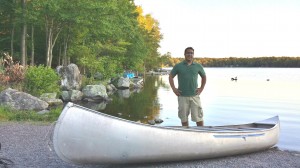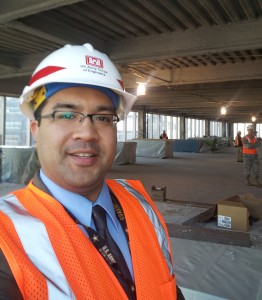You’ve probably heard of the US Army Corps of Engineers and may have an idea what they do. A long-time friend and former colleague, Ravi Ajodah, is the Senior Program Manager and Team Leader for the North Atlantic Division US Army Corps of Engineers’ Environmental Program. He is responsible for the oversight of all military, civilian, interagency and international environmental and munitions cleanup programs throughout the Northeast US and Europe. He’s had a passion for the environment as long as I’ve known him and it’s great to know that someone with that passion is helping to further the Corps of Engineers’ environmental programs. We caught up over the phone to talk about his influences and his career as an environmental professional.
The National Environmental Professional (TNEP): You’ve spent your entire career in the environmental field, was there person or a project that you worked with or on when you realized that this was good, interesting work?
Ravi Ajodah (RA): That’s a tough one, not because I can’t think of any. There’s just so many people and places and projects that I’ve found interesting and confirmed my choice of going into the environmental field. Every time I meet someone new, another environmental professional or at another project or site, I reaffirm the field I’m in is extremely interesting and evolving.
I think if I had to pick one I have to go back to college. I did this project where we rehabbed this greenhouse and a second one where I was doing this aquatic ecology research at Fort Totten (Queens, NY). The work at Fort Totten is really what started my career. A junior in college at that time, it helped me get my first job, at Fort Totten, and that was an early building block to my career and my education. Every day was interesting; every day in the field; every day in the lab. The environmental field as a whole is evolving and challenging and that’s what makes it interesting. It’s not monotonous. You can be doing the same thing over and over again and it will be different every time.
TNEP: You said that when you work with other environmental professionals, it reaffirms your work. What about your interaction with people who aren’t environmental professionals, both work related and friends and family? How is that relationship?
RA: The easy answer is they have no idea what I do. But that’s not the whole picture. The larger picture is that it’s hard for people who are not working in the environmental field or who don’t have it as a personal interest; it’s hard to get their arms around what it is we do. That’s partially because it’s a very large field, literally as large as the environment. You could be doing environmental compliance, cleanup, munitions response, safety, or training as you do, Rick. It’s a very diverse field. To tell someone I’m an environmental scientist or environmental program manager, really there’s so many possibilities to what that could mean that I wouldn’t expect folks who aren’t part of the field to understand them.
One of the things I’ve noticed over the years is that I don’t get the funny looks anymore. You know this as well as I do, Rick. We’d go out to the field and say we’re here for environmental visit and you’d get someone who would absolutely have no clue what that means, or they would look negatively on it, or they would just want to get us out of the way. I don’t see that as much anymore, maybe because it’s a little more main stream. People can associate the environment with something they’ve heard on the news or some other way. It’s not something that’s viewed negatively.
I think where I see things causing the most friction is when we try to integrate environmental processes a little too late in a project or construction. If it’s integrated correctly then really it should be no impact. Let’s use an example of building construction. You have all kinds of permit and NEPA requirements. I remember when I first started, the environmental person was brought in as an afterthought and then it was too late to do anything. I’m seeing more and more environmental professionals are brought in on day one and are fully integrated into the entire design process, say for a construction project or a civil works project and it works really well. That “extra work” that you need to ensure your actions are minimizing impacts to the environment really is done right and integrated into the project are seamless.
TNEP: You’re doing worked related to the Hurricane Sandy relief and recovery. For this and other civil response projects, does the Corps of Engineers try to promote their work to the people and communities they’re supporting? Not the project itself, but the environmental responsible side of the work?
RA: Yes, we do try to promote some of the great things the Corps is doing to reverse past impacts, our contaminated site cleanup program, but we’re integrating it into our civil works project as best we can. The reality is we just don’t do a very good job of that. That’s because we’re really mission focused. Our mission is to perform a civil works project on behalf of the country. How we do that in terms of being as good as we can as environmental stewards. That almost becomes sort of secondary credit. The reality is we’re trying to do our job as best we can in the most responsible manner as possible.
Some of the things I think about are some of the Sandy response actions. The New York district Corps was doing debris removal as part of the response. They ended up diverting most of that waste away from landfills through recycling efforts and wood chipping efforts, recycling concrete. It was a cost savings but it also converted hundreds and thousands of cubic yards of debris out of the waste stream into various recycling programs. That’s something where the team will receive a Corps of Engineers award, but we don’t really promote that outside of the agency.
One of the things that the Corps does do that I think is done well is having these environmental operating principals. It’s basically seven short principles that talk about sustainability and minimizing environmental risk and also promoting response when necessary. That’s integrated throughout the organization. I think the Corps does a good job of promoting environmental processes and the necessity for those well, within the organization. That’s something I noticed right away when I got here.
TNEP: Is there anything you see in the environmental field that is still lacking or not being addressed enough?
RA: That’s a tough one. The environmental field is so wide open. There are so many niches. If I had to pick one thing in the environmental field that we could do better it is breaking down some of the stovepipes within the field. Maybe do more cross sharing of skill sets. One of the things we’re trying to do more of is green remediation. This is where we integrate into our large cleanup projects more sustainable practices, bringing together many parts of the environmental field into one to make our own execution work. I think that brings more to the table for customers and for the public for the best results.
The other thing I’d like to see more of, in terms of projects, is more brownfield-type work where we’re focused on economic growth, and job growth. Taking the next level of an environmental cleanup where we take previously unusable, formerly contaminated land, clean it up and have it be reused for something that would benefit a community. I’d like to see more for a number of reasons. It would then require less new land to be developed and it also returns what may have been unusable back to a community.
 TNEP: You obviously have a passion for this. When you go home, how does that passion influence you at home?
TNEP: You obviously have a passion for this. When you go home, how does that passion influence you at home?
RA: I think this is the case with most people who work in the environmental field. We got into because we have a general interest and we just genuinely like what we do. Definitely didn’t get into for the money. We just like what we do. That helps motivate me. My own person interest really carries over to the office. It doesn’t matter how mundane the task I’m working on at the moment. It doesn’t matter if I don’t like it or it’s something I really don’t feel like doing. It’s that personal interest that I have that carries me through.
I think on the other end of work influencing my life – one of the things is when I learn something new at work. I may learn about sustainable energy or alternative energy or park land that the Corps of Engineers manages. I’ll bring this home and maybe look them up or read something, or even visit some of these sites.
Going back to your question about friends and family, they still do give me funny looks, but they understand that it’s an interest of mine and something I’m passionate about. I’ve always been passionate about, long before professional life, long before I went to college for it. I think they understand it’s not what I do; it’s more who I am.
TNEP: That is a great line, “It’s not what I do; it’s who I am.” That’s awesome and a perfect summary of how many environmental professionals feel about their work and life.
RA: Regarding the profiles of environmental professionals: It’s good to see what everyone else is doing and share that knowledge.
Regarding the profile of the LEED AP+ architect: LEED is almost like a future for the environmental field – having environmental attached to traditional disciplines, such as architecture or engineering. You see it more and more in the health professions.
TNEP: Thanks, Ravi. Hopefully next time we can do this in person over a pint.

